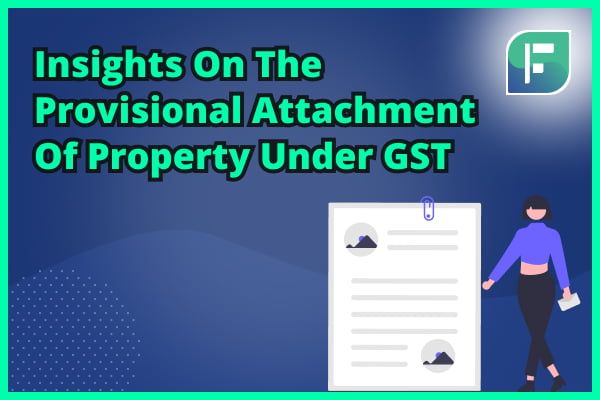The primary goal of the provisional attachment of property under GST is to safeguard the revenue’s interests. It’s possible that all of the legal proceedings under various tax laws, including the goods and services tax, will take a significant amount of time. Delay can take place while in the procuring of income by the public authority because of the condition of forthcoming or anticipating settlement of the relative multitude of procedures.
The taxpayer has the option to transfer his or her property prior to the conclusion of the proceedings. Under GST, the government has the authority to use its provisional attachment power of property (property of the taxpayer) to safeguard revenue interests while any proceedings are pending or awaiting resolution.
Defining Provisional Attachment of Property under GST
Before proceeding with Section 83 of the CGST Act, it is essential to understand the meaning of the provisional attachment of property under GST. The individual can’t make the exchange of his property to some other individual in the event that assuming the public authority attaches the property of that individual.
Nonetheless, if some way or another he figures out how to make the exchange of his attached property, then such a sort of move will not get perceived by regulation, and furthermore, the exchange would be expected to be void. Nonetheless, the financial balance would get attached, movement of assets to different records will not get permitted.
Systematic Exposition Of Section 83 Of The CGST Act
At the conclusion of certain specified proceedings under the CGST Act, 2017, the Commissioner would issue an order authorizing the attachment of property, including taxpayers’ bank accounts, to safeguard the revenue interests.
This order is likely to remain in effect for one year if no action is taken. After receiving a copy of the Commissioner’s order, the relevant Transport Authority, Revenue Authority, or any related authority would obstruct access to the aforementioned property. There is no way to remove the obstacle without receiving instructions from the Commissioner.
Cases When Sec 83 Can be Put into Effect
- No such provision regarding attachment of property of such citizen is appropriate in any unique case.
- Similar to this, the goods and service tax officer can captivate Section 79 of the CGST Act, which deals with tax collection, for provisional attachment of property under GST for closed proceedings.
- It applies to cases where the proceedings have come to an end and the taxpayer has been certified as a defaulter.
- As a result, in some circumstances where certain tax-related proceedings are pending, provisional property attachment under GST (Section 83) is permitted.
Steps that the taxpayer can then take
- The Commissioner has the authority to issue DRC-22 at any time after the demand notice has been issued in accordance with Sections 63, 73, or 74.
- In DRC-22, the Magistrate would pass a request that will incorporate the subtleties connected with the attached property in the event that to go for temporary attachment of property under GST, likewise including financial balance.
- In the same way, notice for attachment would be given after Section 62 or Section 64 assessment orders were issued.
- The taxpayer has the right to file an objection in opposition to the order in DRC-22 upon receipt, arguing that such property will not be subject to attachment.
- The objection ought to be filed within seven days of the property attachment. The Commissioner would then be subjected to additional restrictions in order to provide the taxpayer with an opportunity to be heard.
- In addition, if he found the taxpayer’s response satisfactory, he would issue an order in DRC-23 to release the attached property from his shackles.
- The citizen would either go for settling the relevant expense duty or follow through available cost as a thought for the property, among both whichever is lower in the event that on the off chance that the qualities of the connected property are dubious or responsible to die.
- At the time of settlement, the Commissioner would issue an order in DRC-23 authorizing the release of such property.
- If the taxpayer does not decide to either pay the property’s market price or take another step toward settling the appropriate tax dues, the Commissioner would use his authority to dispose of the property and may also take the appropriate action against the taxpayer’s dues.
Conclusion
Provisional attachment of property under the Goods and Services Tax (GST) is a measure taken by tax authorities to secure the government’s interest in situations where there is a potential tax liability.





